Arriving in Morelia
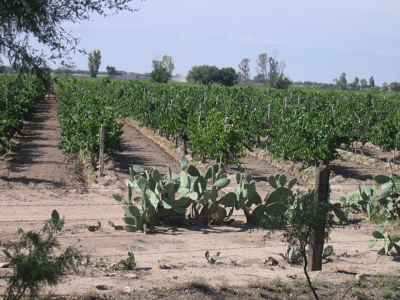 Although only 4 hours between Guanajuato and Morelia, there was
a lot of habitat diversity between the two towns. Leaving desert, we
drove through moist hills, valleys of grapes (coexisting with cacti -
photo on left), more and more dry forest covering the hillsides.
We drove through several tiny villages, their streets barely wide
enough for our car. Horses outnumbered cars and we felt very
conspicuous. Over one last pass and the city of Morelia spread
before us on the valley floor.
Although only 4 hours between Guanajuato and Morelia, there was
a lot of habitat diversity between the two towns. Leaving desert, we
drove through moist hills, valleys of grapes (coexisting with cacti -
photo on left), more and more dry forest covering the hillsides.
We drove through several tiny villages, their streets barely wide
enough for our car. Horses outnumbered cars and we felt very
conspicuous. Over one last pass and the city of Morelia spread
before us on the valley floor.
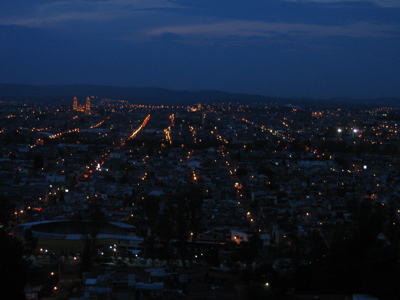
This is a view of town from our living room window.
The cathedral is on the left. Despite it's large population
(we've read estimates of 600,000 to 1 million), the city is manageable.
Other than the cathedral, there are only a few buildings taller
than two stories. Yet the city fits neatly into this small valley.
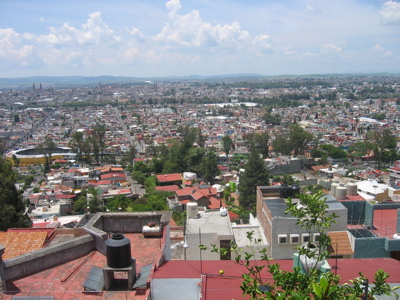 This is the same view as above, during the day.
This is the same view as above, during the day.

Driving in a Mexican city was surprising at first, but we got the hang
of it. There are no stop signs, only "uno y uno": one and one, meaning
that cars at each intersection should take turns. Surprisingly, it
works quite well. Because no one needs to come to a complete stop,
traffic moves faster than if there were stop signs. Stop lights are
long and people take advantage of this by juggling fire in the
intersection (on ladders, with their bodies spray-painted silver!),
washing windshields, and selling everything imaginable.
Mexican paradox #1:
Lines in banks and city offices are long and take hours to
negotiate. People wait patiently. Yet at traffic lights, as
soon as the light turns green, people honk and turn on sirens to let
you know it's time to go! We haven't figured out these divergent
behaviors yet.
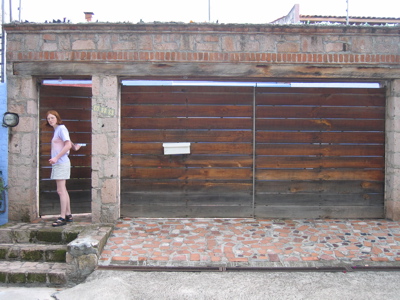
All of the houses are hidden behind gates, fences, and
iron bars so it's hard to get the feeling of a neighborhood. Here
is Margaret outside the house we rented for the first two weeks,
looking like not much more than a wooden gate. Broken glass is
embedded in the top of the wall.
But inside. . . . .

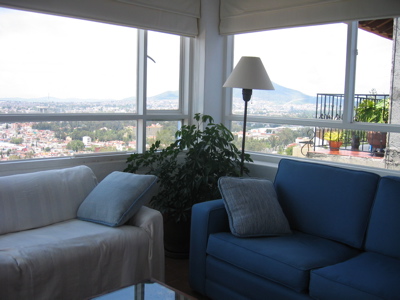
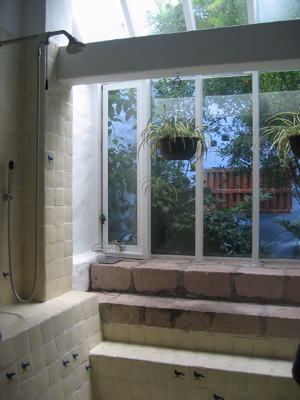
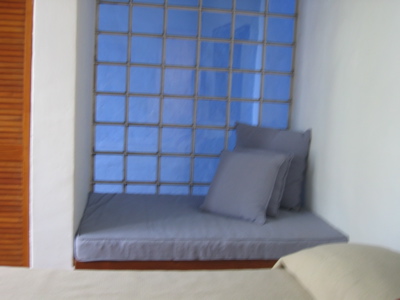
. . . . we found a very comfortable, beautifully furnished
two-bedroom home. Windows and a big skylight allow lots of
natural light and provide a great view of the city. We knew we
were in the lap of luxury and it wouldn't last forever, but it was a
nice place to alight at the start. We learned only later, as we
searched for long-term housing, that the 12 sq. ft. lawn here is a big
"yard"; almost every house in town has either no yard or a small patch
where you can park your car. Already we're looking forward to
running through the grass at home!
We celebrated arriving "home" with a dinner of fresh food: mangos,
guavas, strawberries, guacamole and tortillas (and some pretty awful
wine from Cuatro Cienagas!):
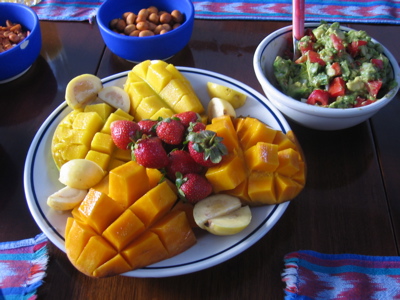
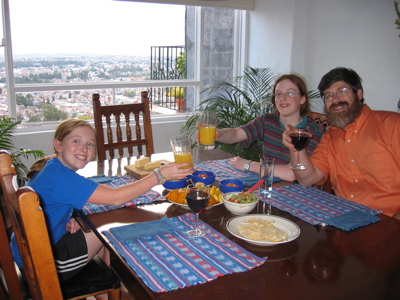
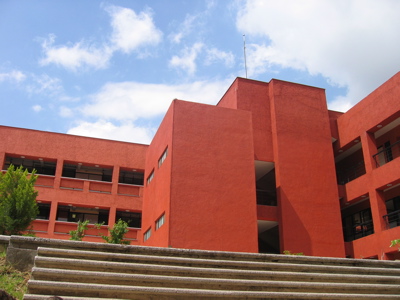
Just to the south-east ot town is the Centro de
Investigaciones en Ecosistemas of UNAM (National University of Mexico)
where we will be working.
We all enrolled in Spanish classes at Baden-Powell for a week: four
hours of classes in the mornings. Don and Helen were in classes
of three students; Margaret and Sarah were in a class to themselves.
Don, Sarah, and Margaret took turns having a stomach bug - we
don't know the source but suspect that we'll all get it eventually.
No one here drinks tap water; a person comes through the streets
daily selling big jugs of clean water. And we're advised to
sterilize the vegetables before we eat them.
Sounds of the streets in Morelia:
1. a hand-held clanging bell signifies the trash truck.
There is no municipal trash pick-up here, so trucks roam the city
collecting people's trash. You pay 5 pesos (50 cents) per bag
that you throw in the truck.
2. a lyrical bell signifies the gas truck. People buy natural gas
by the small tank and these trucks go through neighborhoods at least
daily. Hear the bell and run out with your empty tank and buy a
full one.
3. a steam-generated whistle signifies a steamed sweet potato wagon.
These small steel wagons have little ovens in them; they steam
sweet potatos and left off the excess steam through a whistle.
4. a small hand-held bell signifies the water man. A cart goes
through neighborhoods selling big plastic jugs of clean water.
Come out with your empty jug, pay $1.50 and you'll get a full jug.
5. We've been told that in the winter there are trucks that sell
fire wood. No doubt these have a unique sound, but we haven't
heard them yet.
6. And we're lucky that we live near the zoo and the most common
sound emanating from it is the male lion's grunts and roars as he mates
with one of the four lionesses in his harem. This happens most
often in the middle of the night.
7. There are dogs everywhere: street dogs and owned dogs.
Many seem to live on the rooftops of their houses (remember there
are virtually no yards in the city). They all bark a lot.
From the pattern of services offered by these trucks, it is apparent
that this system evolved with at least one person at home most of the
day (to throw the trash in the truck, buy gas and water). We're
not quite sure how this will work for us when we'll all be gone during
school hours. . . .
Siesta
We are still figuring out the timing of Mexican's days. It is
summer and many people are on vacation and we suspect that what we've
learned so far will become irrelevent when school starts. But,
what we've learned so far: mornings start late. The streets are
pretty empty until 9:00, most stores don't open until 10:00.
People work from 9 until 2:00, when they go home for comida: the
large mid-day meal (that the person who stays at home prepares!): rice
and beans and tortillas and meat. Then everything is quiet until
around 4:00 when people go back to work, where they stay until about 8
or 9:00. Restaurants fill up in late evening. And
then, at least in Morelia, the central plaza fills up with families and
couples until late at night.
We have been trying to adjust our bodies to this new schedule.
The siesta we can handle; starting the day at 9:00 is harder!
Upon arrival in Morelia, both girls wanted their hair cut.




 Although only 4 hours between Guanajuato and Morelia, there was
a lot of habitat diversity between the two towns. Leaving desert, we
drove through moist hills, valleys of grapes (coexisting with cacti -
photo on left), more and more dry forest covering the hillsides.
We drove through several tiny villages, their streets barely wide
enough for our car. Horses outnumbered cars and we felt very
conspicuous. Over one last pass and the city of Morelia spread
before us on the valley floor.
Although only 4 hours between Guanajuato and Morelia, there was
a lot of habitat diversity between the two towns. Leaving desert, we
drove through moist hills, valleys of grapes (coexisting with cacti -
photo on left), more and more dry forest covering the hillsides.
We drove through several tiny villages, their streets barely wide
enough for our car. Horses outnumbered cars and we felt very
conspicuous. Over one last pass and the city of Morelia spread
before us on the valley floor.
 This is the same view as above, during the day.
This is the same view as above, during the day.











